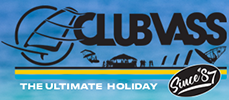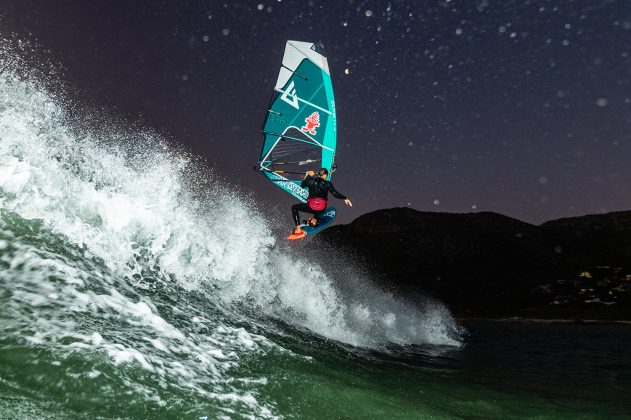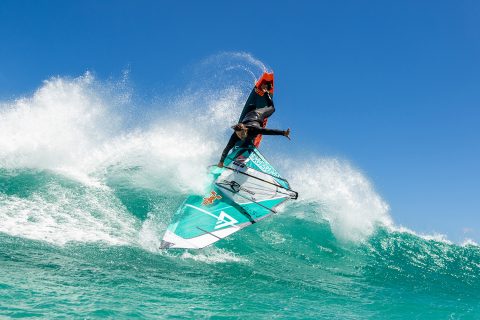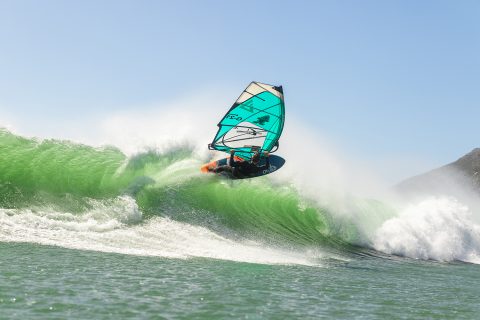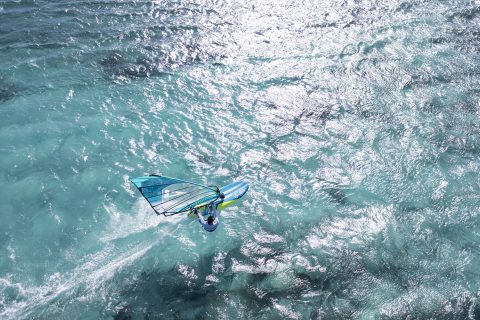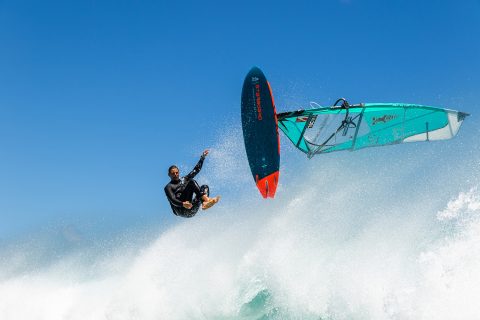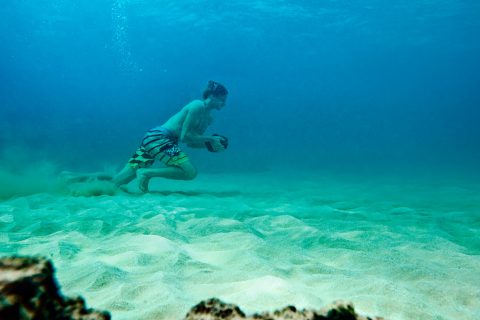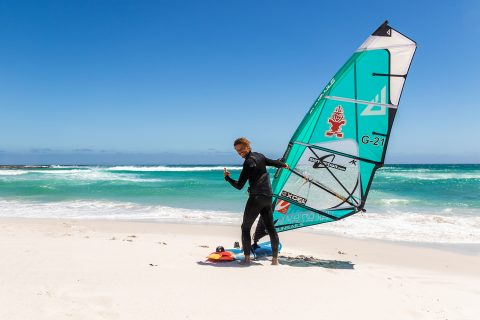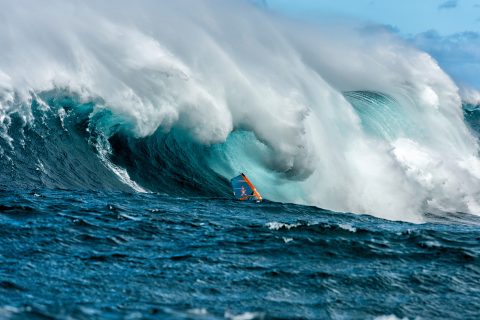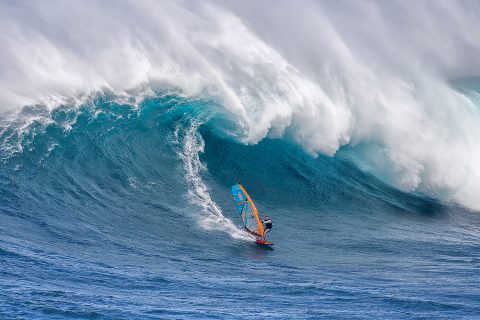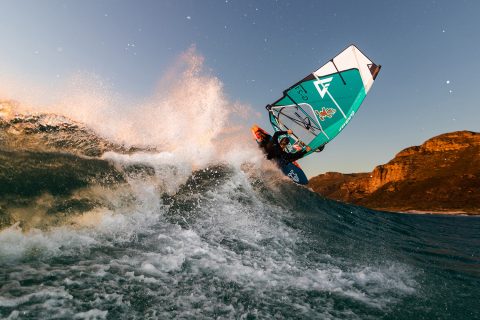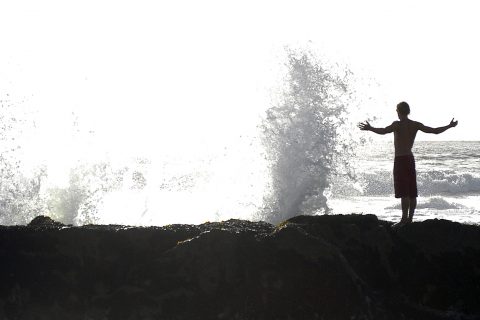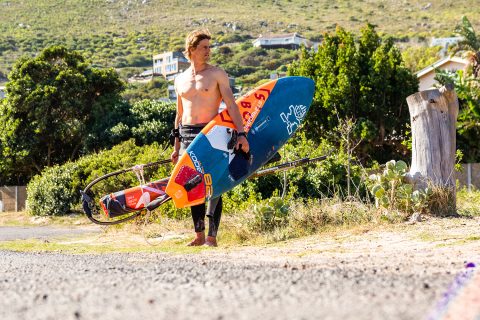GET OUT OF THE COMFORT ZONE: FLORIAN JUNG
In this feature, Florian Jung shares six powerful habits to break through plateaus and rediscover the stoke of windsurfing. Whether you’re chasing your first carve gybe or charging Jaws, it all starts with leaving the comfort zone behind. Florian sets it out with six efficient rituals to improve your windsurfing skills!
Words: Florian Jung // Photos: Sam Tome, John Carter, Fish Bowl Diaries and Pierre Bouras.
When was the last time you had a real moment of success while windsurfing? The feeling of having learned something new or having mastered a difficult situation? Maybe that’s not what it’s all about. Maybe the feeling of joy should always be in the foreground! Of course, there will always be days when things just don’t work out, when the wind is too gusty or suddenly gone. But how can we create the best possible circumstances to really enjoy our goals and our time on the water?
- Flo always making the most of his water time!
Imagine you go on the water with a concrete goal. Let’s say, you want to learn the power gybe. You feel good. Your equipment is perfectly set up, the wind is constant and after a few failed attempts, which were planned, you glide full speed into the turn. Your timing is right – just like you visualized it before. You shift your sail and your board carves into the other direction. Yes, that’s such an amazing feeling. You are on cloud nine and the beer after the session with your surf buddies tastes especially good today.
- Some days it all goes right!
Mastering maneuvers like this is one of the biggest hurdles for many windsurfers. Character traits like resilience, ambition, and willpower should also be subscribed to us as windsurfers if you want to go far. This may not sound like fun to outsiders. There aren’t many sports that are so complicated. Knowing that you don’t give up right away is therefore a huge plus in overcoming many challenges in daily life of windsurfers. But what remains hidden for outsiders is the path to the goal, which is almost always the same. The journey includes a few wipe outs or catapults here and there but always comes with a lot of happiness and inner growth if we conquer a situation or learn something new.
At my Wave Windsurf Camps I always meet participants who feel like they have come to a standstill, who fiddle around with certain maneuvers for years and sometimes seem to despair. Partly because they lack time on the water, partly because they have stopped experimenting or built-up inner blockades. All they need is the conscious feelings of success that come from gradually challenging themselves and growing in a controlled environment with new input.
I am also on this endless journey and certainly not every session is a complete success. But also, the days when things don’t work as planned are part of it – as long as I try to learn from it. These are the moments where I have consciously challenged myself, consciously taken risks and successfully mastered them that make me grow.
For me, the following habits provide an important aspect to maintain this endless joy that windsurfing offers in the long run.
Everyone has different patterns and natures, but these basic characteristics are the same for each of us. Here are a few tips from my daily practice:)
- Flo Jung in the zone!
Be proactive!
As the saying goes. If you don’t change anything, everything stays as it is. No problem – if everything runs perfectly, and you are satisfied. But in the long run this bears the danger of underchallenge, weariness and boredom and this consequently equals a step backwards. For me it is crucial to consciously set new incentives again and again. To have new experiences, to learn and to enjoy the process of growing. Be it a new maneuver, a new spot or our own attitude, how we perceive the world around us.
For me, the idea of a ticking clock helps. Time is the same for everyone. One day our clock will run out and so I ask myself what I want to experience here and now. It is one of the most basic questions, what do you want to do until then.
- Flo enjoying the sensation of speed!
If you take this idea a little further, it results in certain time windows. Life phases in which different things are possible. If your goal is to surf a giant wave or break the 80 km/h mark on your speed board, it’s best not to start when you’re 70 years. To me, being proactive means creating the best possible conditions and setting appropriate goals for where, how and exactly what you want to experience. After 3 windless windsurfing vacations at the Mediterranean Sea, it might be better to book a trip to the Canary Islands next summer! Of course, there can always be divergences, but for me it helps to have a clear direction and then actively follow the path to the summit.
Learn to learn:
Before every windsurf session, I try to get myself in the right mood. Especially before important heats at competitions or on days where the highest concentration is required, I listen to appropriate playlists beforehand to build up a positive basic tension. When it comes to learning maneuvers, I use various techniques, such as feedback through filming, slow-motion training or visualizations. Here and there, the idea of making as many mistakes as possible and deliberately exaggerating them also helps. Falling into the water sometimes to the right, sometimes to the left of the board, to find the golden mean. Smaller intermediate goals help enormously. To stay with our example of the jibe, it might help to focus on switching your stance in the jibe and practice beforehand on land. The next time you try it on the water, you should only concentrate on the foot position and then consciously observe what happens. Often small mistakes make the difference.
- Be prepared to fall!
Windsurfing is a sport with and in nature and therefore the basic conditions are different every day. Sometimes the wind is not quite enough. Sometimes you fly over the water completely overpowered and just want to get back to land in one piece. I find the ability to adapt flexibly and stay creative is one of the most exciting aspects of windsurfing. Sometimes 10 knots on a flat lake are enough to learn the perfect tack.
But to really feel the joy, it helps immensely to share your experiences and unite with like-minded people. For example, at a windsurfing camp or with your surf buddies at your home spot. The main thing is that it’s easy for you to share, push yourself and get possible feedback.
In general, it always starts with the right questions. What do I want and how can I improve myself? What drives me and makes me happy?
- Flo underwater training
Quality vs. quantity:
In windsurfing, as in other areas of life, the principle of the right intention applies to short-term as well as long-term goals. After my last injury break, I created a daily ritual that helped me a lot. Every time before I go out on the water, I check my equipment setup again and check every detail. Foot straps, sail pressure, harness lines, sail trim etc. In this respect I am a perfectionist and want to have the best possible material at the start. An incorrectly rigged sail or board that just won’t plane can end any session in frustration.
- Go for quality equipment!
Afterwards I stand on the beach and take a few deep breaths and imagine what I really want to learn realistically. This so-called “golden” minute helps me get much more out of my session. Whether it’s practicing a new maneuvre or just being on the water and switching off, it’s a way to put my focus in the here and now and leave all other distracting thoughts on the beach. The motto here is: quality vs. quantity. I’d rather do one good turn in the wave with full awareness than try many maneuvers with half-hearted effort.
When I notice that this focus is waning, I take a break or go back to the beach. In the past, I was often on the water for more than 4 hours. Today, that happens relatively rarely. Like that I try to minimize the risk of injury but also always surf with enough power and concentration.
Set the right goals and then let go:
A few years ago, I wrote down a bucket list for myself. ( A list of goals I want to do before I am gone). It listed things like: Surfing Jaws at 45+, sail around the world, win a competition, teach a person with limited ability to windsurf, etc.
Goals give you a direction like a compass needle. But there are not only good goals but also so called “stress goals”. If you ask too much of yourself, if you get out of balance, if you want to learn the loop and if you get tense every time you go out on the water, then you will lose the fun in the long run. The moment we “try hard” we are already tense. Thus, it is one of the biggest “sources of error” there is. It implies a certain weakness and shows that we are not yet up to the challenge. In natural activities, we don’t try. We just do it. We don’t think about it. We drive a car, we write an email, we go for a run. It doesn’t require any effort and it comes easily to us. But when we are faced with a task that we think is a challenge, when self-doubt rises in us, we begin to try. We put up an inner resistance to our goal.
- One ticked off the bucket list!
With less effort, better results can often be achieved. Therefore, it is certainly best to motivate yourself with candy rather than a stick.
Set clear goals in life, make the necessary preparations, and then just let things happen. As the martial arts fighter Bruce Lee once said: Don’t try, do it or don’t do it but don’t try.
Attitude:
When things are starting to go smoothly on the water and you are just so full of self-confidence, the motto is to store this in your subconscious. This requires a lot of repetition. The more precisely we know and feel how something works, the better we can recall it.
During a surf session in the big waves at Pe’ahi, I was caught by a set of 3 waves and experienced probably the hardest wipe out of my life. I got “pounded” by wave after wave and the time underwater felt like an eternity. When I met Watermen Kai Lenny a short time later in the lineup, I saw him sitting completely relaxed on his board and making some jokes. A few meters next to us 10–12-meter giant waves detonated onto the reef. I had my pants more than full and was glad to have survived the last beating. When I asked how he got over such wipe outs so easily, he said in short: “You just get used to it. Before you get worked, smile, take a deep breath, and then see it all as a fun challenge.”
- Flo Jung charging at Jaws
When you’ve done nothing but surf waves of this dimension since childhood, it’s easy to talk. But what remains hidden are the many experiences, the many repetitions that have led to this attitude. Thousands of waves one has ridden before or not, the precise physical preparation with special breathing training. The safety vest with inflatable air chambers, the jet ski assistance as your life insurance. But no matter what preparation you made above all, our attitude is crucial in determining whether we see big waves as something dangerous and if so, how we gradually change this.
The moment I see critical situations with some humour, it is much easier to make clear decisions and e.g. stay relaxed underwater. Of course, it still takes a lot of effort to get out of the comfort zone, but behind it are usually the most precious moments.
This certainly requires a kick in the butt every now and then to overcome, but as long as you don’t feel paralyzing fear, but a healthy amount of excitement, it can be a very valuable experience to live truly extraordinary moments. Whether it’s surfing a wave in Jaws, crossing the shore break on a stormy day at your home spot, or simply learning a new maneuver again, it doesn’t matter. It’s about consciously jumping over your shadow every now and then with calculable risk. Everyone should define for themselves what small or big challenges are and how they can be mastered.
As Henry Ford said, “One thinks he can, the other thinks he can’t, and both are right.”
- The late session in Cape Town…fair play to Sam Tome for swimming!
First sow, then reap:
Change is the only constant. Through change, we always learn new facets in life and get the opportunity to live them out. Sure, it takes courage to try something new and take risks. Discovering talents is one thing, pursuing talents is another. Many people are held back from change by the fear of failure. That’s why it’s so important to review our habitual patterns every now and then and make basic assumptions that will bear fruit later. For something to grow, you must learn how to sow.
In a small way, our mindset but also our daily routines in windsurfing as well as in life in general are therefore of great importance.
How do we learn to acquire new skills with interest that make life better, more valuable, more exciting or do we prefer the status quo? To be happy is above all a state of mind that can only arise within ourselves. In the last 15 years I have had several setbacks, some of them injuries or disappointments in competitions. But these experiences are part of it and can be valuable as long as I learned from them. Like the waves, life remains a daily up and down. For me, it’s about taking the right balance of risks to really build momentum. So, get out of your comfort zone and have fun learning.
- GET OUT OF THE COMFORT ZONE!
If you are more interested in improving your windsurfing skills in a controlled environment, you can sign up for a variety of windsurfing camps around the world. There are tons of great events and coaches and sometimes this little push helps you to push your limits or light the inner fire again.
- Flo Jung
If you are interested, check out my following Wave Windsurf Camps this year:
03.09.- 10.09.2022 Wave Camp Klitmøller
19.11.- 30.11.2022 Wave Camp Cape Town
More info on: www.florianjung.com
Florian Jung is sponsored by:
Starboard
Maui Ultra Fins
AK durable supply company
Xcel Wetsuits

